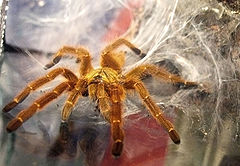- Pterinochilus murinus
-
Pterinochilus murinus 
immature P. murinus Scientific classification Kingdom: Animalia Phylum: Arthropoda Class: Arachnida Order: Araneae Suborder: Mygalomorphae Family: Theraphosidae Subfamily: Harpactirinae Genus: Pterinochilus Species: P. murinus Binomial name Pterinochilus murinus
Pocock, 1897Synonyms Harpactira elevata
Pterinochilus mamillatus
Pterinochilus vosseleri
Pterinochilus hindei
Pterinochilus leetziThe baboon spider Pterinochilus murinus, an old-world tarantula, was first described in 1897 by Reginald Innes Pocock. This species is found on the African continent, in Angola, as well as central, eastern, and southern Africa.
Among those who keep tarantulas as pets Pterinochilus murinus is known as "OBT," which means "Orange Baboon Tarantula" or "Orange Bitey Thing," and also as the "Pterror," a pun on its Latin genus classification: Pterinochilus. These nicknames reference a particular orange color form that is prized in the hobby for its beauty and confrontational personality. It is also known as the Mombasa golden starburst tarantula.
This species is incredibly defensive and should not be held. The bite of this species, while not serious, is extremely painful. Moreover, the species is more than willing to inflict such a bite before presenting the typical threat display. Caution when dealing with this species is advised.
Description
Female P. murinus can grow to 4–6 inches in size (measured from the tip of the front left leg, to the rear right leg), while males typically range from 3–4 inches. The spider's abdomen, carapace, and legs have the same basic coloration, though the legs typically have brightly colored rings. The carapace has a star-shaped pattern, with a fishbone pattern present on the abdomen. The eyes are clustered together on a raised part of the carapace (in common with all tarantulas). The body is covered with short hairs, with longer hair present on the legs.
There are currently 4 known colour variants of Pterinochilus murinus:
TCF - Typical Colour Form, UMV - Usambara Mountain Variant, RCF - Red Colour Form, DCF - Dark Colour Form.
These colour variants are found in different geographical locations, and the colouration is thought to be related to the type of soil present where each variant lives.
References
- Platnick, Norman I. (2009): The world spider catalog, version 9.5. American Museum of Natural History.

This spider–related article is a stub. You can help Wikipedia by expanding it.
